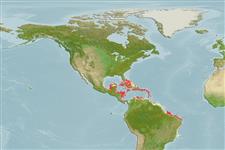>
Gobiiformes (Gobies) >
Gobiidae (Gobies) > Gobiinae
Eponymy: Isaac Ginsburg (1886–1975) was a Lithuanian-born goby taxonomist at the US National Museum and for the US Fish & Wildlife Service. [...] (Ref. 128868), visit book page.
More on author: Fowler.
Environment: milieu / climate zone / depth range / distribution range
Ecologia
marinhas associadas(os) a recifes. Tropical; 27°N -
Western Central Atlantic: The Bahamas, Cayman Islands, and Antilles south to Venezuela and Colombia (Ref. 092840).
Tamanho / Peso / Idade
Maturity: Lm ? range ? - ? cm
Max length : 2.5 cm TL macho/indeterminado; (Ref. 7251)
Espinhos dorsais (total) : 7; Raios dorsais (total) : 12; Espinhos anais: 0; Raios anais : 10. Distinguished by having the following characteristics: dark brown body with nine, bright blue, thin, vertical lines; presence of rostral frenum (Ref. 92840).
Inhabits shallow areas with clear water and coral formations (Ref. 13628), often in close association with the sea urchin Echinometra lucunter. Possesses a ventral sucking disk which allows it to adhere to the rock beneath the test of an urchin with only the head showing among the spines of urchins. When disturbed they retreat farther beneath the urchin, and if the urchin is removed it rapidly darts beneath the test of a neighboring one. Feeds mainly on the tube feet of sea urchins (Ref. 33548)..
Ciclo de vida ou comportamento de acasalamento
Maturidade | Reprodução | Desova | Ovos | Fecundidade | Larvas
Robins, C.R. and G.C. Ray, 1986. A field guide to Atlantic coast fishes of North America. Houghton Mifflin Company, Boston, U.S.A. 354 p. (Ref. 7251)
Status na Lista Vermelha da UICN (Ref. 130435: Version 2024-2)
Ameaça para os humanos
Harmless
Uso pelos humanos
Pescarias: espécies comerciais; Aquário: Espécies comerciais
Ferramentas
Relatórios especiais
Baixar XML
Fontes da internet
Estimates based on models
Preferred temperature (Ref.
123201): 26.7 - 28.2, mean 27.5 °C (based on 600 cells).
Índice de diversidade filogenética (Ref.
82804): PD
50 = 1.0000 [Uniqueness, from 0.5 = low to 2.0 = high].
Bayesian length-weight: a=0.01023 (0.00477 - 0.02194), b=3.01 (2.83 - 3.19), in cm total length, based on LWR estimates for this (Sub)family-body shape (Ref.
93245).
Nível Trófico (Ref.
69278): 3.0 ±0.00 se; based on food items.
Resiliência (Ref.
120179): Elevada, tempo mínimo de duplicação da população menor que 15 meses (Preliminary K or Fecundity.).
Fishing Vulnerability (Ref.
59153): Low vulnerability (10 of 100).
Nutrients (Ref.
124155): Calcium = 383 [168, 1,323] mg/100g; Iron = 1.93 [0.82, 4.27] mg/100g; Protein = 18 [16, 20] %; Omega3 = 0.17 [0.05, 0.54] g/100g; Selenium = 40.1 [11.9, 113.9] μg/100g; VitaminA = 90.2 [17.0, 456.9] μg/100g; Zinc = 4.8 [2.6, 8.0] mg/100g (wet weight);
